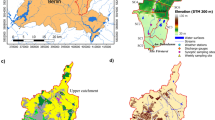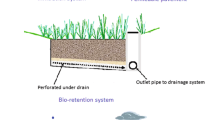Abstract
Pervious pavements offer a solution for rainwater runoff treatment in urban areas, combining storm-water management with water reuse purposes when the sub-bases become rainwater reservoirs. Furthermore, the thermal behaviour research into these systems has demonstrated their contribution to palliating the urban heat island effect in the hottest season and to delaying freezing during the coldest season. Recent investigations related to pervious pavements and their sub-bases have enabled the use of these structures combined with Ground Source Heat Pumps (GSHP) in addition to the other well-known applications. The aim of this field study is to investigate the temperature response observations of the water stored in the sub-bases of different pervious pavements under specific conditions, in order to evaluate the possibility of introducing GSHP technology. The base and sub-base temperatures of different types of pervious pavements were monitored during one year and the results obtained show the differences in pervious pavements temperature compared to air temperature over the period of study; and demonstrate that the sub-base is less affected by the air temperature than the base, due to the insulating capacity of pervious pavements. On the other hand, water samples were taken from the different pervious pavement sub-bases in order to assess the water quality deterioration due to the temperatures reached in the sub-base, focused on investigating the presence of Legionella in this particular aquatic environment.








Similar content being viewed by others
References
Asaeda T, Ca VT (2000) Characteristics of permeable pavement during hot summer weather and impact on thermal environment. Build Environ 35:363–375
Bäckström M (2000) Ground temperature in porous pavement during freezing and thawing. J Transp Eng 126(5):375–381
Brattebo BO, Booth DB (2003) Long-term stormwater quantity and quality performance of permeable pavement systems. Water Res 37:4369–4376
Ca and Asaeda (1997) Evaporation at the surface of permeable pavement and its impacts on the urban thermal environment. Proceedings, Congress 27th of the International Association of Hydraulic Research, (IAHR). San Francisco, California, United States, New York, NY: American Society of Civil Engineers, Vol A: 104-109
Coupe SJ, Charlesworth S, Faraj AS (2009) Combining permeable paving with renewable energy devices: installation, performance and future prospects. Proceedings, 9th International Conference on Concrete Block Paving. Buenos Aires, Argentina, Argentina Concrete Block Association 2009
Day GE, Smith DR, Bowers J (1981) Runoff and pollution abatement characteristics of concrete grid pavements. Bulletin 135, Virginia Water Resources Research Center, Virginia State University. USA
Field R, Masters H, Singer M (1982) Status of porous pavement research. Water Res 16(6):849–858
Fields BS (1996) The molecular ecology of legionellae. Trends Microbiol 4(7):286–290
Fields BS, Benson RF, Besser RE (2002) Legionella and Legionnaires’ Disease: 25 years of investigation. Clin Microbiol Rev 15(3):506–526
Gilbert JC, Clausen JC (2006) Stormwater runoff quality from asphalt paver, and Crushed Stone Driveways in Connecticut. Water Res 40:826–832
Gomez-Ullate E, Castillo-Lopez E, Castro-Fresno D, Bayon JR (2010) Analysis and contrast of different pervious pavements for management of storm-water in a parking area in Northern Spain. Water Resource Management 25(6):1525–1535
Kaini P, Artita K, Nicklow JW (2012) Optimizing structural best management practices using SWAT and genetic algorithm to improve water quality goals. Water Resources Management 26(7):1827–1845
Kevern JT, Schaefer VR, Wang K (2009) Temperature behaviour of pervious concrete system. Transportation Research Record: Journal of Transportation Research Board 2098:94–101
Legret M, Colandini V (1999) Effects of a porous pavement with reservoir structure on runoff water: water quality and fate of heavy metals. Water Sci Technol 39(2):111–117
Newman AP, Pratt CJ, Coupe S, Cresswell N (2002) Oil biodegradation within permeable pavements by microbial communities. Water Sci Technol 45(7):51–56
Panagopoulos Y, Makropoulos C, Mimikou M (2011) Diffuse surface water pollution: driving factors for different geoclimatic regions. Water Resources Management 25(14):3635–3660
Pratt CJ (1999) Use of permeable, reservoir pavement constructions for stormwater treatment and storage for re-use. Water Sci Technol 39(5):145–151
Pratt CJ, Mantle JD, Schofield PA (1989) Urban stormwater reduction and quality improvement through the use of permeable pavements. Water Sci Technol 21(8–9 pt 3):769–778
Pratt CJ, Mantle JD, Schofield PA (1995) UK research into the performance of permeable pavement, reservoir structures in controlling stormwater discharge quantity and quality. Water Sci Technol 32(1):63–69
Raimbault G, Balades J-D, Faure-Soulet A (1985) Quatre expérimentations françaises de chaussées poreuses. Bulletin de liaison des laboratoires des ponts et chaussees 137:43–55
Rodriguez J, Castro D, Calzada MA, Davies JW (2005) Pervious pavement research in Spain: structural and hydraulic issues. Tenth International Conference on Urban Drainage, Copenhagen/Denmark, pp 21–26
Sanner B, Karytsas C, Mendrinos D, Rybach L (2003) Current status of ground source heat pumps and underground thermal energy storage in Europe. Geothermics 32(4):579–588
Scholz M, Grabowiecki P (2007) Review of permeable pavement systems. Build Environ 42:3830–3836
Scholz M, Grabowiecki P (2009) Combined permeable pavement and ground source heat pump systems to treat urban runoff. J Chem Technol Biotechnol 84:405–413
Tota-Maharaj K, Scholz M, Ahmed T, French C, Pagaling E (2010) The synergy of permeable pavements and geothermal heat pumps for stormwater treatment and reuse. Environ Technol 31(14):1517–1531
Wanphen S, Nagano K (2009) Experimental study of the performance of porous materials to moderate the roof surface temperature by its evaporative cooling effect. Build Environ 44:338–351
Author information
Authors and Affiliations
Corresponding author
Rights and permissions
About this article
Cite this article
Novo, A.V., Bayon, J.R., Castro-Fresno, D. et al. Temperature Performance of Different Pervious Pavements: Rainwater Harvesting for Energy Recovery Purposes. Water Resour Manage 27, 5003–5016 (2013). https://doi.org/10.1007/s11269-013-0270-y
Received:
Accepted:
Published:
Issue Date:
DOI: https://doi.org/10.1007/s11269-013-0270-y




